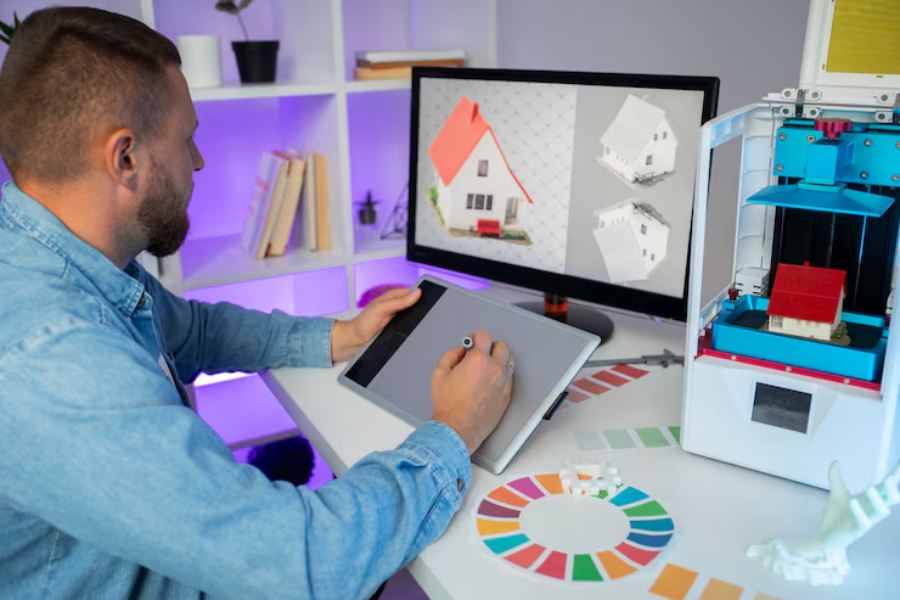The Evolution of the Graphic Designer Role in the Digital Era

The job of the graphic designer has changed significantly in the quickly changing digital era. Formerly limited to print media, the graphic designer role now includes websites, social media, motion graphics, and generative artificial intelligence tools. Knowing this evolution is vital as 2025 approaches, not only for those working in the field but also for companies and teachers helping to create the future of graphic design.
A Historical Perspective
What started with printing press typography in medieval times changed to logos and posters by the middle of the 20th century. Even today, if you go to your local museum, you can catch some really cool graphic designer posters on display. But the landscape changed forever with the introduction of digital tools like Photoshop, Illustrator, and QuarkXPress. Now, designers no longer had to carve out designs and cut and paste them manually. They could simply create a digital prototype, which could be reused endlessly. The graphic designer role had changed.
A pioneering woman who brought computers into the creative process, April Greiman was a major player during this change and linked analog and digital sensibilities. Susan Kare’s logo work for early Macintosh computers changed pixel art and interface design at the same time. These trailblazers paved the way for today’s digital graphic designer, who is at ease with everything from complicated conceptual work to technical interfaces.
Digital Media and Platforms
Designers had to be flexible as digital platforms (websites, mobile applications, social media) expanded. Responsive layout, UX/UI features, digital branding, motion graphics, and interactive content were among the areas graphic design embraced. Designers started to include visual narrative into digital user interactions and to optimize for several screen sizes.
With digital graphic designers creating funnels of visual material across Instagram, TikTok, and developing platforms, social media helped to magnify this trend. Styled posts, animated Reels, and temporary stories call for fresh skill sets. Therefore, designers started to integrate tools like After Effects and Figma into their processes.
Motion, UX, and AI
Today’s graphic designer is part designer, part animator, and part technologist:
- Motion and interactive design: The designer’s view now includes motion graphics, kinetic typography, animated infographics, and interactive UI components.
- UX/UI and product design: the border between graphic and product design keeps becoming blurry. Designers now engage in user testing, wireframing, and prototyping, tasks typically taken on by UX professionals.
- AI‑powered design: Design powered by artificial intelligence has suddenly exploded. Automating ideation, color recommendations, layout creation, and even writing cues, Adobe, Canva, and other services provide AI‑aided creation. Research studies demonstrate that generative artificial intelligence is seen as a creative partner, helping with ideation and arrangement tasks.
The graphic designer role is changing from maker to curator in this age. Designers now choose, improve, and elevate designs done by AI with human guidance.
Graphic Design Trends in 2025: What’s On the Horizon
Looking ahead to graphic design trends 2025, a number of ideas are catching fire:
- AI‑powered design: Designed using artificial intelligence, not as a shortcut but as an assistant for idea generation, repeated layout, and customized creative inspiration.
- Bold minimalism: The power of simplicity – bold typefaces and vivid central
- Metallics & Future Dusk: Chromium hues and the WGSN‑inspired Future Dusk deep blue-violet color scheme rule 2025.
- Pixel nostalgia: Early digital aesthetics and pixel nostalgia bring back retro tech sensibilities.
- Shapes & textured grains: Organic shapes, photo-cropped shapes, and tactile grain textures deepen depth and materiality through forms and textures.
- Functional & serene: Japandi‑inspired quiet designs with subdued color palettes, natural components, and uncluttered layouts are popular.
- Hand‑drawn & scrapbooking styles: Adding warmth and genuineness through handcrafted elements, stickers, and collage methods called hand‑drawn and scrapbooking styles.
Combining technological advancement with emotional resonance, these are key for the future of graphic design.
The Changing Expectations of a Graphic Designer Role
Customers and employers are demanding change with the advancements in technology. Some of the main changes:
- Multidisciplinary proficiency: Today’s graphic designers frequently combine motion, UI/UX, print, AR/VR prototyping, and generative artificial intelligence processes.
- Strategic thinking: Designers are supposed to comprehend branding, user behavior, and data analytics beyond basic visual skills.
- Collaborative approach: Cross-functional work by designers with marketing, development, and data teams helps to create consistent end-to-end experiences.
- Ethics, access, and sustainability: Ethical design is no longer optional. In their process, designers need to take into account eco‑materials, color access, diversity, and inclusion.
AI and Job Security
The rising impact of artificial intelligence brings both opportunities and worries. We now have real accounts of graphic designers being replaced by AI-created content. Entry-level positions are especially in danger since AI technology enables logos, layouts, and social media images in just a few clicks.
Generative artificial intelligence is driving creative professionals to change and concentrate on higher-level abilities that computers cannot duplicate, like brand strategy, user empathy, and visual storytelling.
Skills and Adaptation
To thrive in the digital future, graphic designers should:
- Welcome artificial intelligence as a partner, not a rival. Understand Adobe Firefly, DALL·E, Midjourney.
- Upskill using Figma, Sketch, After Effects, Lottie, etc., in motion graphics and UX/UI.
- Develop a multidisciplinary attitude by incorporating brand narrative, data, and interactivity into visual projects.
- Stay trend-aware and understand the psychological basis for the comeback of minimalism, texture, and pixelation.
- Champion ethical and sustainable design: Accessibility (WCAG), eco‑friendly materials, and inclusive visual cultural representation should all take precedence.
The Future of Graphic Design: Beyond 2025
Looking beyond, several developments will influence the future of graphic design:
- With growing AR/VR adoption, graphic designers are essential to spatial, interactive brand experiences—often alongside motion designers and developers.
- Dynamic, data‑driven visuals: Generative visualizations that auto‑adapt to user data and context.
- Ethical AI and explainability: Designers will have to examine and report on the way AI-driven graphics are being created.
- Sustainability embedded design systems: Consistent colors, typefaces, and designs related to a reduced environmental impact.
In this changing environment, the job of the digital graphic designer turns from simply maker to curator. Designers have to become more than just artists. They must be strategists and cultural guardians for the digital age.
Conclusion
We have seen the role of the graphic designer change with the times as new technologies emerge, from a print-focused visual expert to a multifaceted digital creator, strategist, and technologist. In 2025, understanding graphic design trends like AI-powered design and other in-vogue emerging trends must be on every designer’s checklist. Do not fear AI – embrace it. With the right use, generative technologies can be your most trusted tool rather than a threat to your job. This will decide the future of graphic design.
